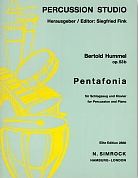Pentafonia for Percussion and strings, op. 53a (1974)
I. Fantasia
III. Notturno
IV. Intermezzo
V. Conclusion
Percussion: gong (50 cm), vibraphone, cymbals (50-45-40-35 cm), cymbal 45 cm (sizzle) 20 cm (bell), 2 tom-toms, snare drum, 2 bongos, 5 temple blocks, 2 woodblocks
First
performance: May 6, 1975, München, Hochschule für
Musik
Hermann Gschwendtner / Münchener Kammerorchester / Hans
Stadlmair
African
first performance: January 11, 1983, Cairo,
American University, Erwart Memorial Hall
Siegfried
Fink / The Cairo Conservatoire Orchestra / Ernst Schelle
Duration: 26 Minutes
Publisher:
N. Simrock Hamburg-London (Boosey & Hawkes)
Piano
reduction: EE 2856 / ISMN: 979-0-2211-0810-4
Video: Works by Hummel on youtube
The focal point of this work is the group of solo percussion instruments with their great range of possible sonorities and tone colours.
In the first movement (Fantasia) horizontal layers of sound (mainly on vibraphone and assorted cymbals) and the opposition of short characteristic motives are explored. The percussion ideas are extended and inverted by the strings permeating one another and resulting in fascinating colour modulations.
The second movement (Allegro ritmico) is dominated by concerto principles and features the opposition of two bodies of sound, the string ensemble on one hand and doums and wooden instruments on the other.
In the third movement (Nottturno) a chorale like episode is interrupted by a recitative-like cadenza on the vibraphone. The chorale-like material appear four times in different versions.
The fourth movement (Intermezzo) treats, the doums and metal instruments virtuosically. A short cadenza for the soloist developing material previously heard, comes just before the end of the movement.
In the large-scale construction of final movement possibilities already explored are condensed and formally reorganized culminating in a "quasi" development of material from the first four movements. The work closes with hushed pianissimo coda.
Press
Süddeutsche Zeitung, May, 1975
The name of this work is derived from its five-movement form and was conceived by the composer in the years 1973/74. The variety of percussion effects incorporated into this piece is astonishing. But Hummel's convincing compositional achievement is the integration of the impulses which are provided by the percussion into the string sound. He has managed this most convincingly.
Hannoversche Zeitung, 21st May, 1979
This work was composed in 1974 to satisfy the justified wishes of percussionists; its charming effects are produced by a relatively small percussion group which, with a secure feel for intimate, floating sounds but also for fundamental rhythmical effects, is presented in contrast and in combination with the string ensemble parts with their numerous tremolo and superimposed layer effects.
Rheinische Post, 25th January, 1978
Hummel's Pentafonia proved to be an interesting study in sonorities involving a percussion ensemble (drums, temple blocks, cymbals, tam-tam and vibraphone) and a 12-piece string ensemble. But anyone who thought they were in for an energetic burst of thunder was mistaken. The accents lay rather on magically mysterious filigree work in the strings - in contemporary colours, of course. The soloist, Wolfgang Schneider, presented in contrast at one moment music of the spheres, the next moment bubbling, intensifying, virtuoso passages. The young percussionist was equal to the most recondite rhythmical figures.
Mittelbayerische Zeitung, Regensburg, 18th May, 1977
The Pentafonia for percussion and strings is highly interesting and successful experiment in sound, allowing the formal structure to be heard even without linear thematic material, a genuine composition, in other words, demonstrating how beautiful percussion instruments can be.
